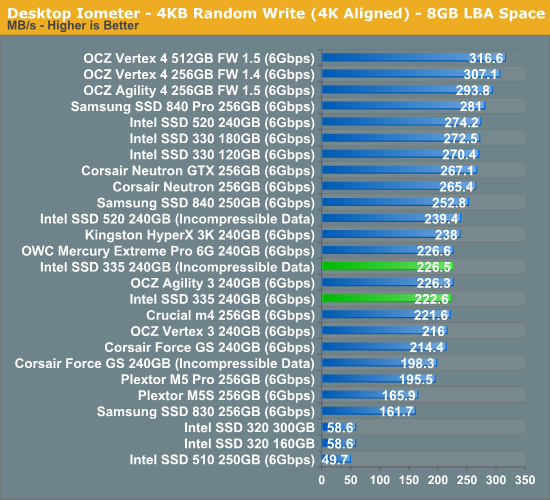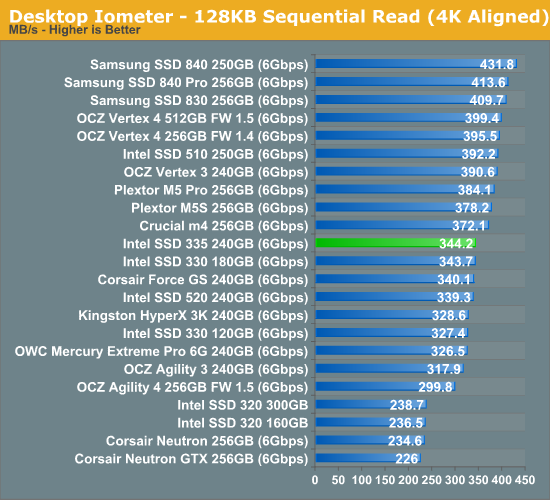Intel SSD 335 (240GB) Review
by Kristian Vättö on October 29, 2012 11:30 AM ESTRandom Read/Write Speed
The four corners of SSD performance are as follows: random read, random write, sequential read and sequential write speed. Random accesses are generally small in size, while sequential accesses tend to be larger and thus we have the four Iometer tests we use in all of our reviews.
Our first test writes 4KB in a completely random pattern over an 8GB space of the drive to simulate the sort of random access that you'd see on an OS drive (even this is more stressful than a normal desktop user would see). I perform three concurrent IOs and run the test for 3 minutes. The results reported are in average MB/s over the entire time. We use both standard pseudo randomly generated data for each write as well as fully random data to show you both the maximum and minimum performance offered by SandForce based drives in these tests. The average performance of SF drives will likely be somewhere in between the two values for each drive you see in the graphs. For an understanding of why this matters, read our original SandForce article.

Random read performance has never been SandForce's biggest strength and even Intel couldn't massively improve it with its own firmware. The SSD 335 is in fact slower than the SSD 330 here.


Random write speed at small queue depths is also slower compared to the 520 and 330, although at queue depth of 32 the difference is negligible.
Sequential Read/Write Speed
To measure sequential performance I ran a 1 minute long 128KB sequential test over the entire span of the drive at a queue depth of 1. The results reported are in average MB/s over the entire test length.


Sequential read performance is identical to SSD 330, but sequential write speed is slightly slower. What's notable is sequential write performance with incompressible data: the Intel SSD 335 manages to beat both the 520 and Corsair's Force GS by a noticeable margin.










69 Comments
View All Comments
MrSpadge - Tuesday, October 30, 2012 - link
"It is always impressive to think about performance going up with subsequent NAND generations"Well.. it might be impressive, but nevertheless it's a false assumption (if NAND generations are defined by lithography - newer interfaces could be implemented on the same lithography just as well).
Kristian Vättö - Tuesday, October 30, 2012 - link
My point was that overall performance has gone up even though the NAND is slower.mmonnin03 - Tuesday, October 30, 2012 - link
As for the comment about stocks of 25nm flash... IMFT/Micron are still making a significant amount of 25nm NAND as well as some 34nm chips.CristianM - Wednesday, October 31, 2012 - link
you wrote on average 1000 times the capacity of the disc but that does not translate in write cycles because there is the nasty write amplification which seems to be about 3 for your testcase, so there you have it. But for an average user writing 10GB per day it would take many years to wear (68) or about 7 years for writing 100G which seems unlikely for a home userCristianM - Wednesday, October 31, 2012 - link
My bad, the write amplification is taken into account, so just divide by 10 :D and the lifespan drops to 7 years for medium use and 1 year for a mad torrent user :))bankster66 - Friday, November 2, 2012 - link
Trim needs:series 7 chipset (Z77 Z78) - NOT Z68
11.5+ Intel RST OROM in bios
11.6+ Intel RST driver pak
Preferably Win 8
"RAID falls under the T10 specifications. These specs require the UNMAP command to be issued to TRIM the drive. No current Microsoft operating systems supports the UNMAP command so regardless of driver or OROM RAID arrays will not be Trimmed. Win8 will be the first MS operating system with an API in place to support the UNMAP command "
There is no way in hell you can get trim functioning with your setup, all prereqs are wrong
Per Hansson - Saturday, November 3, 2012 - link
I don't know what you are on to make an accusation like that.TRIM is supported by Windows 7
It requires the AHCI drivers in Windows to be used, or any other driver that specifically mentions that it supports TRIM.
What you are referencing is TRIM support with 2x harddrives in a RAID-0 array, and that has a long list of requirements, but how that is relevant to this Intel 335 single drive review is beyond me.
http://www.anandtech.com/show/6161/intel-brings-tr...
Bruno2 - Tuesday, March 12, 2013 - link
I noticed the following firmware update for the SSD Series 335. Perhaps this was the reason for the endurance test problems.November 2012
3.1.2
This release adds a firmware update for the Intel® SSD 335 Series fixing the following issue :
- Incorrect reporting of the E9h media wear indicator value
Bruno2 - Tuesday, March 12, 2013 - link
FYI, I noticed the following firmware update for the SSD Series 335.November 2012
3.1.2
This release adds a firmware update for the Intel® SSD 335 Series fixing the following issue :
- Incorrect reporting of the E9h media wear indicator value